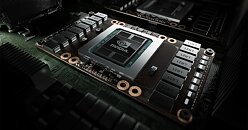Friday, January 3rd 2020

NVIDIA's Next-Generation Ampere GPUs to be 50% Faster than Turing at Half the Power
As we approach the release of NVIDIA's Ampere GPUs, which are rumored to launch in the second half of this year, more rumors and information about the upcoming graphics cards are appearing. Today, according to the latest report made by Taipei Times, NVIDIA's next-generation of graphics cards based on "Ampere" architecture is rumored to have as much as 50% performance uplift compared to the previous generations of Turing GPUs, while using having half the power consumption.
Built using Samsung's 7 nm manufacturing node, Ampere is poised to be the new king among all future GPUs. The rumored 50% performance increase is not impossible, due to features and improvements that the new 7 nm manufacturing node brings. If utilizing the density alone, NVIDIA can extract at least 50% extra performance that is due to the use of a smaller node. However, performance should increase even further because Ampere will bring new architecture as well. Combining a new manufacturing node and new microarchitecture, Ampere will reduce power consumption in half, making for a very efficient GPU solution. We still don't know if the performance will increase mostly for ray tracing applications, or will NVIDIA put the focus on general graphics performance.
Source:
Taipei Times
Built using Samsung's 7 nm manufacturing node, Ampere is poised to be the new king among all future GPUs. The rumored 50% performance increase is not impossible, due to features and improvements that the new 7 nm manufacturing node brings. If utilizing the density alone, NVIDIA can extract at least 50% extra performance that is due to the use of a smaller node. However, performance should increase even further because Ampere will bring new architecture as well. Combining a new manufacturing node and new microarchitecture, Ampere will reduce power consumption in half, making for a very efficient GPU solution. We still don't know if the performance will increase mostly for ray tracing applications, or will NVIDIA put the focus on general graphics performance.

227 Comments on NVIDIA's Next-Generation Ampere GPUs to be 50% Faster than Turing at Half the Power
Also, if any of this is true, Im not expecting prices to return to normal any time soon....in fact it will probably just get worse.
Reminds me of Intel's PR these days with multiple ***
Would be great if there's truth to this though
..Amazeballs.
That will be so worth spending another $1000+ for.
i have my MSI GTX 970 Twin Frozer since 2014 , is very very good graphic card on my Samsung CF791 4k monitor ultra wide 21:9 .
i wait so much time to can buy this RTX 3080 because the RTX 2080 is so expensive for 4k performance / price
i hope the RTX on in 4k are very good in this new next gen NVIDIA .
Keep in mind mainstream res. 1080p. By an immense margin. People have no urge, Pascal's midrange can push most of the games just fine, still. That's a 2016 release..
So no, I think we'll see a jump. 50%, not so sure, indeed. But 25-30% (as usual) definitely.4K will always be a tough one. Especially when RT gets bigger. I'd accept 1080p on that panel for the next half decade if I were you ;)
4K and ultrawide though. It doesn't exist.
Nvidia math is worse than Intel math.
When moving to a smaller node, you either get X% higher performance @ the same power or same performance using Y% less power, but not both.
50% more performance at half the power? BS.
Nvidia: what shall we do? Lets spread news about the next gen to prevent ppl buying big navi.
Big Navi is a rumor at this point, just like Ampere or whatever name Nvidia may call it.
I doubt that Nvidia will lower prices though. They won't have a reason to unless Intel comes out with something really good this year for competition. Also, if there are shortages for any reason then we can expect retailer gouging which will make prices higher than they should be for awhile after release.
That's Nvidia alright!